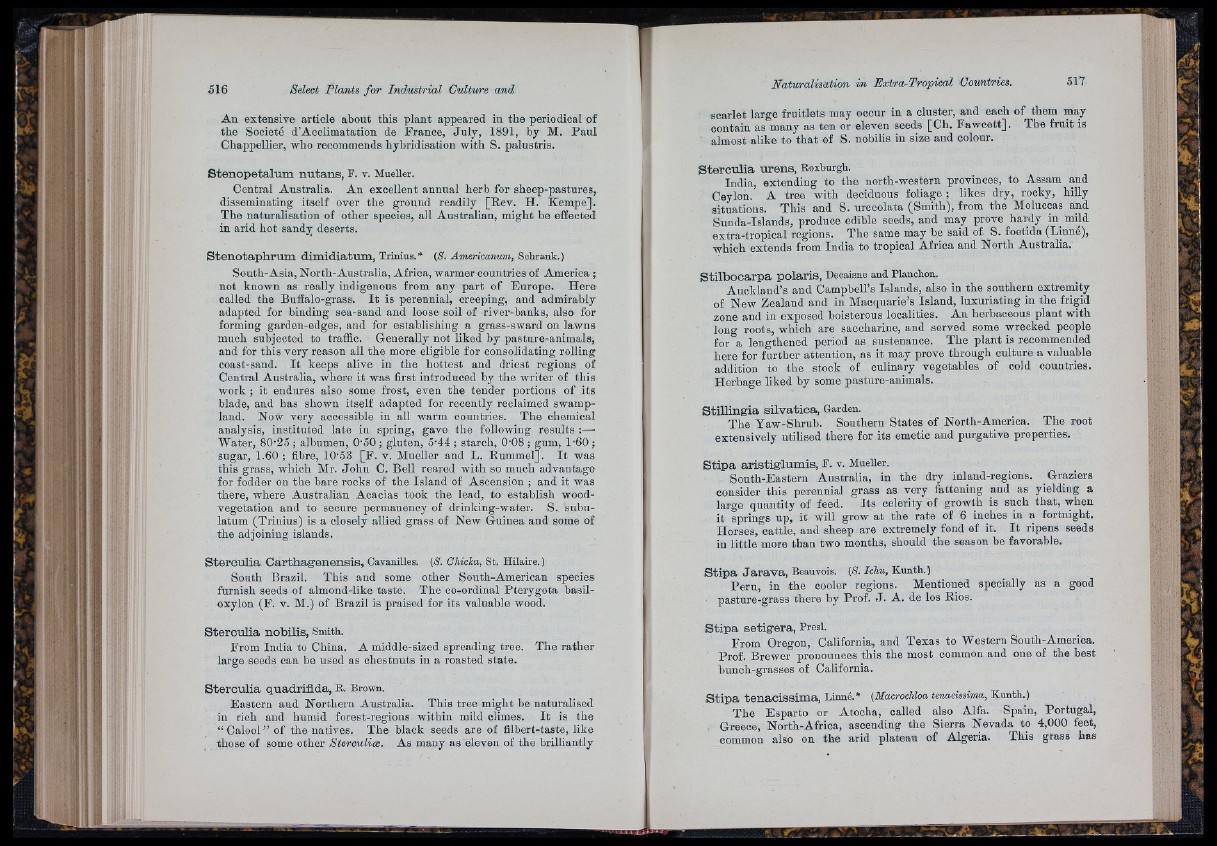
An extensive article about this plant appeared in the periodical of
the Société d’Acclimatation de France, Ju ly , 1891, by M. Paul
Chappellier, who recommends hybridisation with S. palustris.
S t e n o p e t a lu m n u t a n s , P. v. Mueller.
Central Australia. An excellent annual herb for sheep-pastures,
disseminating itself over the ground readily [Rev. H. Kempe].
The naturalisation of other species, all Australian, might be effected
in arid hot sandy deserts.
S t e n o t a p h r u m d im id i a tu m , Trinius.* (8. Americanum, Schrank.)
South-Asia, North-Australia, Africa, warmer countries of America ;
not known as really indigenous from any part of Europe. Here
called the Buffalo-grass. I t is perennial, creeping, and admirably
adapted for binding sea-sand and loose soil of river-banks, also for
forming garden-edges, and for establishing a grass-sward on lawns
much subjected to traffic. Generally not liked by pasture-animals,
and for this very reason all the more eligible for consolidating rolling
coast-sand. I t keeps alive in the hottest and driest regions of
Central Australia, where it was first introduced by the writer of this
work ; it endures also some frost, even the tender portions of its
blade, and has shown itself adapted for recently reclaimed swampland.
Now very accessible in all warm countries. The chemical
analysis, instituted late in spring, gave the following results :—
Water, 80'2o ; albumen, O’oO; gluten, 5’44 ; starch, 0 ‘08 ; gum, 1-60;
sugar, 1.60; fibre, 10‘o3 [F. v. Mueller and L. Rummel]. I t was
this grass, which Mr. Jo h n C. Bell reared with so much advantage
for fodder on the hare rocks of the Island of Ascension ; and it was
there, where Australian Acacias took the lead, to establish wood-
vegetation and to secure permanency of drinking-water. S. subu-
latum (Trinius) is a closely allied grass of New Guinea and some of
the adjoining islands.
S t e r c i i ii a C a r th a g - e n e n s is , Cavanilles. {S. GhicM, St. Hilaire.)
South Brazil. This and some other South-Amerioan species
furnish seeds of almond-like taste. The co-ordinal Pterygota basil-
oxylou (F. V. M.) of Brazil is praised for its valuable wood.
S t e r c u l i a n o b ilis , Smith.
From India to China. A middle-sized spreading tree,
large seeds can be used as chestnuts in a roasted state.
The rather
S t e r c u l i a q u a d r if id a , B. Brown.
Eastern and Northern Australia. This tree might be naturalised
in rich and humid forest-regions within mild climes. I t is the
“ Calool ” of the natives. The black seeds are of filbert-taste, like
those of some other Sterculia. As many as eleven of the brilliantly
scarlet large fruitlets may occur in a cluster, and each of them may
contain as many as ten or eleven seeds [Ch. Fawcett]. The fruit is
almost alike to th a t of S. nobilis in size and colour.
S t e r c u l i a u r e u s , Roxburgh.
India, extending to the north-western provinces, to Assam and
Ceylon. A tree with deciduous foliage ; likes dry, rocky, hilly
situations. This and S. urceolata (Smith), from the Moluccas and
Sunda-Islands, produce edible seeds, and may prove hardy in mild
extra-tropical regions. The same may be said of S. foetida (Linné),
which extends from India to tropical Africa aud North Australia.
S t i lb o c a r p a p o la r is , Decaisne and Planchon.
Auckland’s and Campbell’s Islands, also in the southern extremity
of New Zealand and in Macquarie’s Island, luxuriating in the frigid
zone and in exposed boisterous localities. An herbaceous plant with
long roots, which are saccharine, and served some wrecked people
for a lengthened period as sustenance. The plant is recommended
here for further attention, as it may prove through culture a valuable
addition to the stock of culinary vegetables of cold countries.
Herbage liked by some pasture-animals.
S tiR iu g i a s i lv á t i c a , Garden.
The Yaw-Shrub. Southern States of North-America. The root
extensively utilised there for its emetic and purgative properties.
S t i p a a r i s t ig lu m i s , F- v. Mueller.
South-Eastern Australia, in the dry inland-regions. Graziers
consider this perennial grass as very fattening and as yielding a
large quantity of feed. Its celerity of growth is such that, when
it springs up, it will grow a t the rate of 6 inches in a fortnight.
Horses, cattle, and sheep are extremely fond of it, I t ripens seeds
in little more than two months, should the season be favorable.
S t i p a J a r a v a , Beauvois. (8. Ichu, Kuuth.)
Peru, in the cooler regions. Mentioned specially as a good
pasture-grass there by Prof. J . A. de los Rios.
S t i p a s e t ig e r a , Presl.
From Oregon, California, and Texas to Western South-America.
Prof. Brewer pronounces this the most common and one of the best
bunch-grasses of California.
S t i p a t e n a c i s s im a , Linné.* (MacrocUoa tenacissima, Kunth.)
The Esparto or Atocha, called also Alfa. Spain, Portugal,
, Greece, North-Africa, ascending the Sierra Nevadu to 4,000 feet,
common also on the arid plateau of Algeria. This grass has